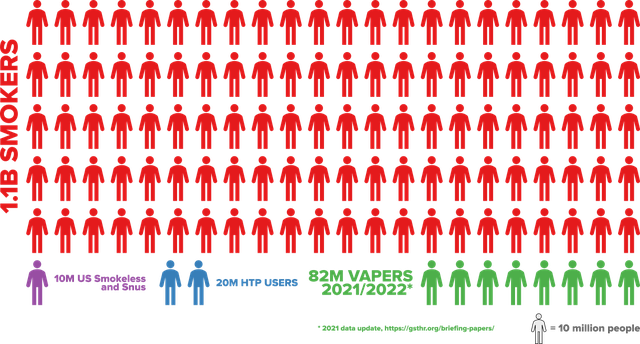Tobacco harm reduction is a potentially life-saving intervention for millions of people across the world. To those who currently use high-risk tobacco products, like cigarettes and some oral tobaccos, it offers the chance to switch to a range of safer nicotine products (SNP) that pose fewer risks to their health.
Most people know that tobacco use is harmful to health and that people use tobacco to consume nicotine. It is less well known that nicotine itself does not cause the severe illnesses associated with high-risk tobacco products like cigarettes. Nicotine is a comparatively low-risk drug, but its effects encourage repeated use. This is one of the reasons people find it hard to stop smoking, even when they know it is bad for their health.
The most dangerous way of using nicotine is by burning a cigarette and inhaling the smoke. Burning tobacco releases tar and gases containing thousands of toxins, many of which pose a risk of severe illness, leading to premature death in half of all smokers. Some oral tobacco products also release dangerous toxins when consumed.
In contrast, safer nicotine products are non-combustible: none of them burn tobacco and some of them do not contain any tobacco at all. They include nicotine vapes (e-cigarettes), nicotine pouches, Swedish-style snus (an oral tobacco), many US smokeless (chewing) tobaccos and heated tobacco products. Many of these products have only been developed in the last 10 – 15 years.
Patches and gums represent another category of tobacco harm reduction product called nicotine replacement therapy (NRT).
SNP provide another option for people who want to reduce the harm connected to their use of nicotine. Many consumers report that they like vaping, using nicotine pouches, snus or heated tobacco products as they offer a more satisfying replacement for some of the habits and behaviours of smoking compared with other methods of quitting smoking.
Research carried out by the Global State of Tobacco Harm Reduction estimates that there are 112 million users of safer nicotine products worldwide.

The evidence from many countries indicates that smokers are switching to lower risk products. For example, there are clear signs of substitution effects – that SNP are replacing smoking – including in the following countries:
- Norway: 15% of young women use snus but only 1% smoke. It has one of the lowest levels of female smoking in the world and young women use snus rather than cigarettes.
- Japan: Sales of cigarettes have fallen by a third since the introduction of heated tobacco products.
- Sweden: Swedish men have switched from smoking to using snus. As a result, Sweden has the lowest rate of tobacco-related disease in Europe. Sweden is the only EU state to have reached smoke-free status, defined as less than 5% adult smoking prevalence.
- Great Britain: The uptake of vaping has been accompanied by a rapid decline in smoking and vapes are the most popular way to stop smoking. 3.6 million people vape in Great Britain, of whom 2.4 million have completely quit smoking.
- New Zealand: The rapid uptake of vaping (from 0.9% adults in 2016 to 6.2% in 2021) has been associated with a dramatic fall in smoking – from 14.5% to 9.4%.
Find out more about tobacco harm reduction in our Briefing Paper here.